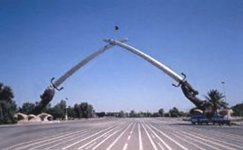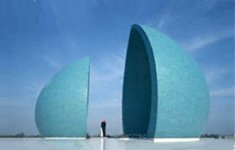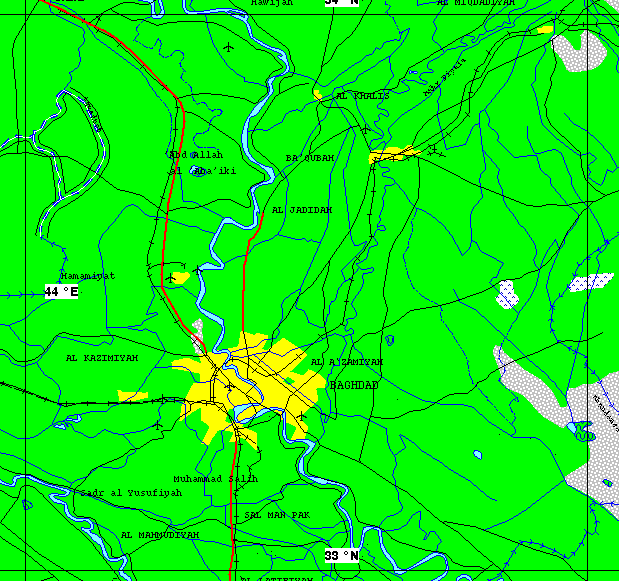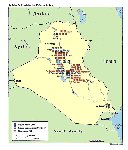





Baghdad is the capital of Iraq and the centre of air, road, and rail transport in the country. As the leading manufacturing city of Iraq, The city has numerous oil refineries, food-processing plants, tanneries, and textile mills. Baghdad suffered damage from allied bombing during the Persian Gulf War in 1991.
The city of Baghdad was founded in AD762 by Abu Jafar al-Mansur, the second Abbasid caliph, on the west bank of the Tigris River. The capital was surrounded by a cricular wall, and became known as the "Round City". Baghdad was at the height of its commercial prosperity during the 8th and 9th centuries AD, and between the 8th and 12th centuries, Baghdad was a flourishing center of Arab civilization. The stories of Scheherazade as told in the Arabian Nights give an idea of life about 800 AD in the court of one of the most famous Abbasid rulers, Caliph Harun ar-Rashid. Baghdad became a famous center of learning in the Middle Ages, and by the tenth century was regarded as the intellectual center of the world. As capital of the caliphate, Baghdad was also to become the cultural capital of the Islamic world.
The Abbasid caliphs' power subsequently weakened, and in 1258, Baghdad was overrun by Mongolian conquerers under Hulagu Khan, who killed the last Caliph, massacred Baghdad's population and destroyed the city and countryside. In 1401 the Mongol leader Tamerlane (Timur the Lame) sacked Baghdad and massacred many of its inhabitants. By the beginning of the 16th century Baghdad's irrigation systen was in dis-repair and the population was reduced to 150,000. Iraq became a land of small kingdoms. The Ottomans maintained Iraq as a Sunni-controlled buffer state.
At the end of World War I, the League of Nations gave Great Britain a mandate to administer Iraq until it established its own government. The British placed a member of the Hashemite family, Faisal ibn Husayn, on the throne as King Faisal I in 1921. Oil reserves in Iraq began to be developed in 1931 under an agreement signed by the Iraqi government and a number of international oil companies. Full independence was achieved in 1932, when the British Mandate was officially terminated. Iraq was a constitutional monarchy until 1958, when a group of army officers overthrew the government. In 1963 the Arab Socialist Resurrection Party, known as the Baath party, seized power. The oil boom of the 1970s brought wealth to Baghdad, and the city was developed on an impressive scale. The city stretches along both banks of the Tigris, with the district of Rusafah on the east and the district of Karkh on the west. Eleven bridges connect the two halves of the city, with a total population of 5 million people. During the 1970's and 1980's money from oil revenues was allocated to building of new monuments in Baghdad. Saddam Hussein laid out new ceremonial avenues and ordered large monuments raised at the city�s major intersections. He has built two victory arches in the capital, an unknown soldier�s tomb, a martyrs� memorial and dozens of small statues and fountains. An amusement park is located at the martyr�s memorial, a playground is next to the triumphal arches, and a theater is located within the complex of the triumphal arches. According to Samir Al-Khalil, author of The Monument: Art, Vulgarity and Responsibility in Iraq (1991), many of Iraq's war memorials were commissioned before the supposed victories they celebrate were even declared.


The colossal Hands of Victory monument has dominated Baghdad's skyline since the end of the Iran-Iraq war. Built in duplicate, it marks the entrances to a large new parade ground in central Baghdad. The triumphal arch is shaped as two pairs of crossed swords, made from the guns of dead Iraqi soldiers that were melted and recast as the 24-ton blades of the swords. Captured Iranian helmets are in a net held between the swords. And surrounding the base of the arms are another 5,000 Iranian helmets taken from the battle field. The fists that hold the swords aloft are replicas of Saddam Hussein�s own hands.
The Shaheed Monument, opened in 1983, commemorates Iraqi soldiers killed in the Iran-Iraq war. Muhammad at-Turki�s elegant martyr�s monument is a circular platform 190 meters in diameter, that sits in the middle of a huge artificial lake. It features an enormous turquoise tiled dome, resembling those topping Baghdad�s mosques. The dome is split down the middle, with the two halves offset, and the walls of the dome sheltering an eternal flame.
The Monument to the Unknown Soldier is said to be inspired by the glorification of a martyr from the Iran-Iraq war. What looks like to many as a flying saucer frozen in midflight, represents a traditional shield (dira�a) dropping from the dying grasp of an Iraqi warrior. The monument also houses an underground museum.


 Baghdad Ministry of Defense Old |
 Baghdad Baath Party Headquarters |
 Baghdad Directorate of Military Intelligence Headquarters, |
 Secretariat Presidential |
 The special group of UN Special Commission for Iraq (UNSOM) weapons inspectors, diplomats and representatives of the International Atomic Energy Agency (IAEA) completed its initial inspections of Iraqi presidential sites on 02 April 1998. It took eight days to complete the so-called baseline inspections of the presidential sites. Access to these sites, which Iraq had declared off limits to the United Nations, was granted only after Secretary General Kofi Annan signed an agreement with Iraqi President Saddam Hussein during his visit to Baghdad last month which allows UN weapons experts, accompanied by a special group of "diplomatic observers," to inspect the compounds. Unfettered access to these and other sites is one of the conditions that must be met to complete the weapons inspections and ultimately lift UN sanctions.
All eight "presidential sites" visited appeared to be well defined by high walls or fences. They all had a rather similar landscape pattern: main guesthouses, with an integrated system of ancillary buildings and villas for accompanying dignitaries. Often an artificial lake with small artificial decorative islands located in a way to give access to the lake from each guesthouse. The mission was not intended to be a search for prohibited material and none was found. In fact, there was very little equipment, documentation or other material in the sites at all. It was clearly apparent that all sites had undergone extensive evacuation. In all the sites outside of Baghdad, for example, there were no documents and no computers. The buildings were largely empty. A key accomplishment of the mission was to plot more precisely the boundaries of the presidential sites.
The special group of UN Special Commission for Iraq (UNSOM) weapons inspectors, diplomats and representatives of the International Atomic Energy Agency (IAEA) completed its initial inspections of Iraqi presidential sites on 02 April 1998. It took eight days to complete the so-called baseline inspections of the presidential sites. Access to these sites, which Iraq had declared off limits to the United Nations, was granted only after Secretary General Kofi Annan signed an agreement with Iraqi President Saddam Hussein during his visit to Baghdad last month which allows UN weapons experts, accompanied by a special group of "diplomatic observers," to inspect the compounds. Unfettered access to these and other sites is one of the conditions that must be met to complete the weapons inspections and ultimately lift UN sanctions.
All eight "presidential sites" visited appeared to be well defined by high walls or fences. They all had a rather similar landscape pattern: main guesthouses, with an integrated system of ancillary buildings and villas for accompanying dignitaries. Often an artificial lake with small artificial decorative islands located in a way to give access to the lake from each guesthouse. The mission was not intended to be a search for prohibited material and none was found. In fact, there was very little equipment, documentation or other material in the sites at all. It was clearly apparent that all sites had undergone extensive evacuation. In all the sites outside of Baghdad, for example, there were no documents and no computers. The buildings were largely empty. A key accomplishment of the mission was to plot more precisely the boundaries of the presidential sites.
This site in Baghdad was visited on 1 and 2 April 1998. In addition to the Deputy Prime Minister, the Minister for Oil and the Secretary to the President, who were regularly present at all sites, the Minister for Foreign Affairs and the Minister for Information were also present. The aerial survey by helicopter was postponed to 2 April 1998, when the helicopter flew for 45 minutes with aerial photography being conducted. Two diplomats were present in the helicopter. The Iraqi authorities expressed concerns over flights above populated areas, which they claimed had been avoided in the past, and questioned the functional need for aerial photography when U2 imagery was available. In finally agreeing to the flight they maintained this was not to be cited as a precedent. The experts conducted what they considered to be a baseline survey of the site with the cooperation of the Iraqi authorities. Issues concerning the entry into family living quarters occupied by the staff of the Palace and other matters were quickly resolved either at the field level or through the intervention of higher authorities. Discrepancies between the earlier survey and ground evidence were settled with the use of GPS equipment. Where documents were available a random check was conducted smoothly. Spot checking of computers was undertaken with the cooperation of the Iraqi authorities.
